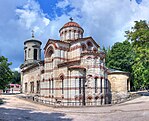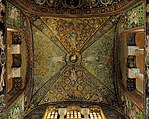
Back Bisantynse argitektuur Afrikaans عمارة بيزنطية Arabic Arquiteutura bizantina AST Bizans memarlığı Azerbaijani Византия архитектураһы Bashkir Візантыйская архітэктура Byelorussian Византийска архитектура Bulgarian Bizantijska arhitektura BS Arquitectura romana d'Orient Catalan Byzantská architektura Czech
From left to right: Hagia Sophia in Turkey, Basilica of San Vitale in Italy, Church of St John the Baptist in Crimea, Basilica of San Vitale | |
| Years active | 4th century – 1453 |
|---|---|
| Byzantine culture |
|---|
 |
Byzantine architecture is the architecture of the Byzantine Empire, or Eastern Roman Empire, usually dated from 330 AD, when Constantine the Great established a new Roman capital in Byzantium, which became Constantinople, until the fall of the Byzantine Empire in 1453. There was initially no hard line between the Byzantine and Roman Empires, and early Byzantine architecture is stylistically and structurally indistinguishable from late Roman architecture. The style continued to be based on arches, vaults and domes, often on a large scale. Wall mosaics with gold backgrounds became standard for the grandest buildings, with frescos a cheaper alternative.
The richest interiors were finished with thin plates of marble or coloured and patterned stone. Some of the columns were also made of marble. Other widely used materials were bricks and stone.[1] Mosaics made of stone or glass tesserae were also elements of interior architecture. Precious wood furniture, like beds, chairs, stools, tables, bookshelves and silver or golden cups with beautiful reliefs, decorated Byzantine interiors.[2]
Early Byzantine architecture drew upon earlier elements of Roman and Greek architecture. Stylistic drift, technological advancement, and political and territorial changes meant that a distinct style gradually resulted in the Greek cross plan in church architecture.[3] Civil architecture continued Greco-Roman trends; the Byzantines built impressive fortifications and bridges, but generally not aqueducts on the same scales as the Romans.
This terminology was introduced by modern historians to designate the medieval Roman Empire as it evolved as a distinct artistic and cultural entity centered on the new capital of Constantinople (modern-day Istanbul) rather than the city of Rome and its environs. Its architecture dramatically influenced the later medieval architecture throughout Europe and the Near East.
- ^ Dimitriu Hurmuziadis, Lucia (1979). Cultura Greciei (in Romanian). Editura științifică și encyclopedică. p. 93.
- ^ Graur, Neaga (1970). Stiluri în arta decorativă (in Romanian). Cerces. p. 38.
- ^ "Byzantine architecture".
© MMXXIII Rich X Search. We shall prevail. All rights reserved. Rich X Search



